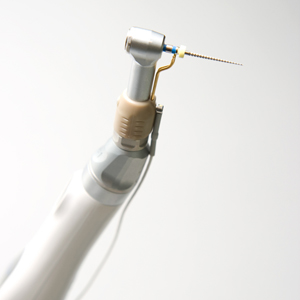
BACKGROUND: Mr G makes an emergency appointment at his dental surgery complaining of severe pain on chewing at LR4. His regular dentist is on holiday so the patient is examined by Dr B. The tooth is tender to percussion with no response to cold, and the adjacent buccal mucosa is painful on palpation.
A periapical radiograph reveals clear radiolucency surrounding the root apex of LR4 and this along with the clinical signs suggest a diagnosis of necrotic pulp with symptomatic periodontitis. Treatment options are discussed, including extraction or root canal treatment (RCT). Mr G opts for private RCT.
The patient returns the next day for a pulp extirpation under local anaesthesia. Dr B removes the existing restoration and during the subsequent procedure notes excessive bleeding but attributes this to hyperaemic pulp tissue. A temporary dressing is applied and the patient is advised to attend his regular dentist for the remaining treatment.
Two weeks later Mr G attends Dr T, who has by then returned from holiday. Dr T examines the tooth and notes a small perforation at the gingival margin. Subsequent attempts to complete the RCT reveals bleeding at the base of the access cavity with a communication to the periodontal ligament and surrounding bone. The patient is informed and a referral is made to a specialist endodontist. On the basis of MDDUS advice, the practice provides a written apology to Mr G with an offer to meet all reasonable costs associated with the repair and restoration of LR4.
A month later Mr G attends a specialist endodontist who undertakes a periapical radiograph, revealing a significant perforation in the mesial aspect of LR4. Remedial treatment is undertaken but he notes the need for further complex care to ensure the long-term viability of the tooth.
Mr G is unhappy and raises a complaint with the GDC over the "poor standard" of treatment provided by Dr B. He also claims to have not been made aware of the relevant risks/potential complications prior to RCT; nor did Dr B inform him of the significant bleeding during the procedure.
The GDC sends a letter to Dr B informing her of the complaint and requesting employment details, proof of indemnity and copies of the patient records. She is further informed that an assessment will be undertaken by a clinical adviser to determine whether any further action is required in regard to her fitness to practise.
ANALYSIS/OUTCOME: Dr B contacts MDDUS and an adviser writes to her offering reassurance and a reminder to notify her local health board of the matter. Dr B is also encouraged in the meantime to consider undertaking CPD relevant to the case, in the event that the GDC should decide to instigate an investigation.
Five weeks later Dr B is informed by the GDC that the information relating to the complaint does not amount to an allegation of impaired fitness to practise – but some aspects of the care provided did fall below the “level reasonably expected” in certain aspects.
In a report on the case, the GDC clinical adviser states that, given Mr G’s claim to have not been told of the treatment risks, it is possible that he did not have sufficient information to make an informed decision. The adviser is also critical of Dr B’s failure to use dental dam isolation and of the standard of the access canal at LR4 – but there is no criticism in regard to the easily missed diagnosis of tooth perforation, even with excessive bleeding. Despite the criticisms made, the GDC takes the view that the concerns raised do not meet the threshold for further investigation of Dr B’s fitness to practise.
The GDC informs Dr B and the health board that no further action will be taken in the matter.
KEY POINTS
- Check that patients understand material risks in procedures to ensure informed consent.
- Record risks discussed and ensure these are noted in a signed treatment plan.
- Use dental dam when clinically indicated.
This page was correct at the time of publication. Any guidance is intended as general guidance for members only. If you are a member and need specific advice relating to your own circumstances, please contact one of our advisers.
Save this article
Save this article to a list of favourite articles which members can access in their account.
Save to library
